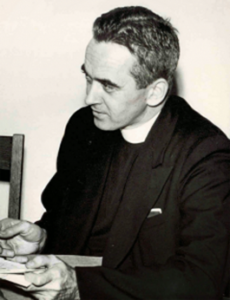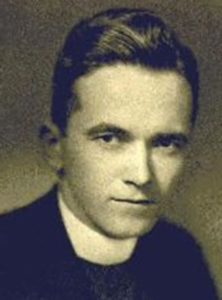Our founder
Father Thomas J. Carroll
A pioneering leader in developing rehabilitation services for the newly blinded adults, Father Thomas J. Carroll was instrumental in our founding. Learn more about the trailblazer the center was ultimately renamed in honor of below in his short biography.
Thomas J. Carroll, Jr. was born in Gloucester, Massachusetts on August 6, 1909. Carroll attended Gloucester High School, graduating in 1928. He then went on to study Greek, Latin, and Philosophy at Holy Cross College in Worcester, MA, graduating in 1932. Deciding to become a priest, he attended St. John’s Seminary, and was ordained in 1938.
His first assignment was to the Catholic Guild for all the Blind as Assistant Director.
During World War II he worked extensively with blinded veterans. He served from 1944-1947 as auxiliary chaplain of Avon Old Farms Convalescent Hospital, the U.S. Army’s Experimental Rehabilitation Center in Connecticut. From 1944-1949, Carroll also held a similar post at Valley Forge General Hospital in Phoenixville, Pennsylvania. In 1947, he succeeded Father Connelly as Director of the Catholic Guild for the Blind.
In 1952, Father Carroll brought the idea of safe travel skills to the Center in the form of the first mobility (cane travel) program.
In 1954, Father Carroll established St. Paul’s Rehabilitation Center for the Blind. The Center was the first civilian facility offering comprehensive rehabilitation for the newly blinded.
In 1961, Father Carroll published a book on the rehabilitation of the blind that won international recognition: Blindness: What It Is, What It Does, And How to Live with It (Little, Brown & Co.). Translated into many languages, it has served to provide a model for many centers throughout the world.
 Always seeking to apply the latest in research to the needs of the blind, in 1963, Father Carroll founded the American Center for Research in Blindness and Rehabilitation. In 1965, he convinced the Archdiocese of Boston to transform a home for Aged Blind Women into a geriatric rehabilitation center (St. Raphael’s Geriatric Adjustment Center) to address the growing problems of aging and vision loss. This initiative proved to be too progressive for the times, as government funding was not available which forced the Center to merge with the St. Paul’s Rehabilitation Center in 1973.
Always seeking to apply the latest in research to the needs of the blind, in 1963, Father Carroll founded the American Center for Research in Blindness and Rehabilitation. In 1965, he convinced the Archdiocese of Boston to transform a home for Aged Blind Women into a geriatric rehabilitation center (St. Raphael’s Geriatric Adjustment Center) to address the growing problems of aging and vision loss. This initiative proved to be too progressive for the times, as government funding was not available which forced the Center to merge with the St. Paul’s Rehabilitation Center in 1973.
Throughout his career, Father Carroll served on many national and international committees, including the President’s Committee on Employment of the Handicapped, and the Special Legislative Commission, which studied problems of blind children and their families in Massachusetts.
Father Thomas Carroll died suddenly on April 24, 1971, leaving a legacy of ideas and an institution to carry on his vision. During his life he was the recipient of nearly 100 national and international honors in work for the blind, including an honorary L.L.D. degree from Holy Cross and the Bell Greve Memorial award of the National Rehabilitation Association.
Transcripts of Father Carroll’s BVA Speeches
Transcripts for all of Father Carroll’s speeches given to the Blinded Veterans Association are available for download in Microsoft Word format.
Father Carroll Taking Part in the Selma Marches
Father Carroll was vitally interested in the changes that were sweeping through post-war America. In early March of 1965, he watched on TV with the rest of America as unarmed demonstrators in Selma, Alabama were gassed and brutally beaten by white officers. When the Reverend Martin Luther King Jr. made a national appeal to clergy of all denominations to join him in Selma for a second march on March 9th, Carroll answered the call. Read Blindness Field Legend Took Part in Selma Marches for more information and to watch the video.


